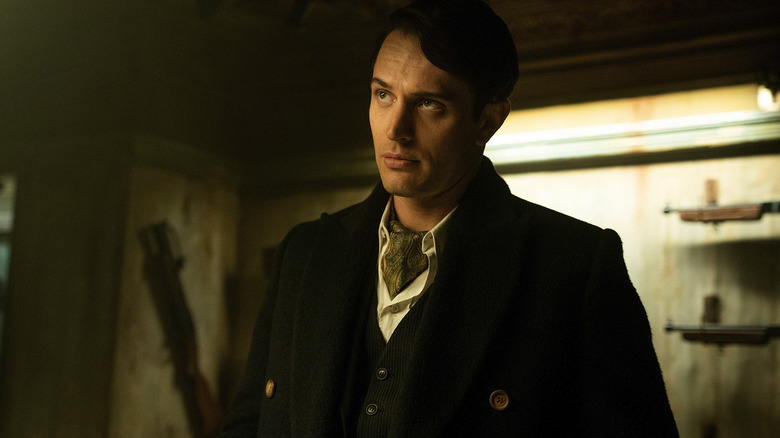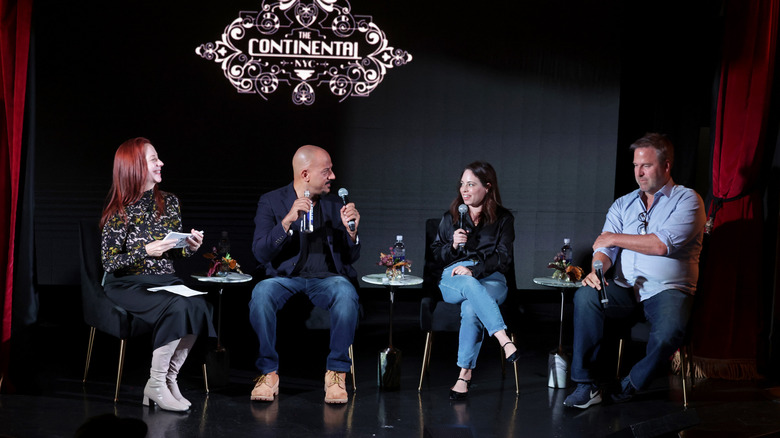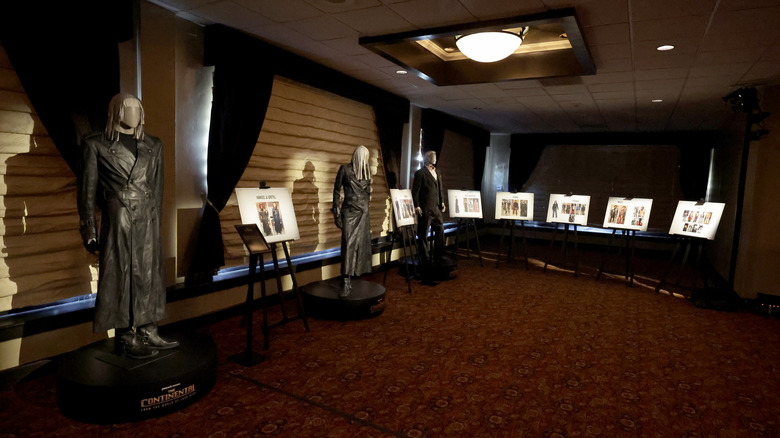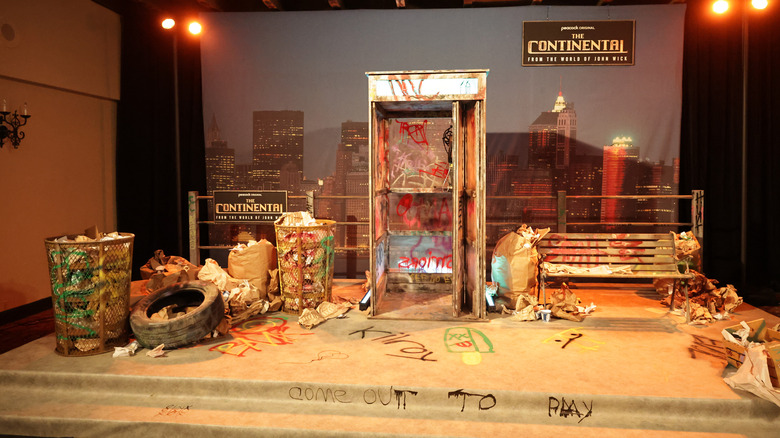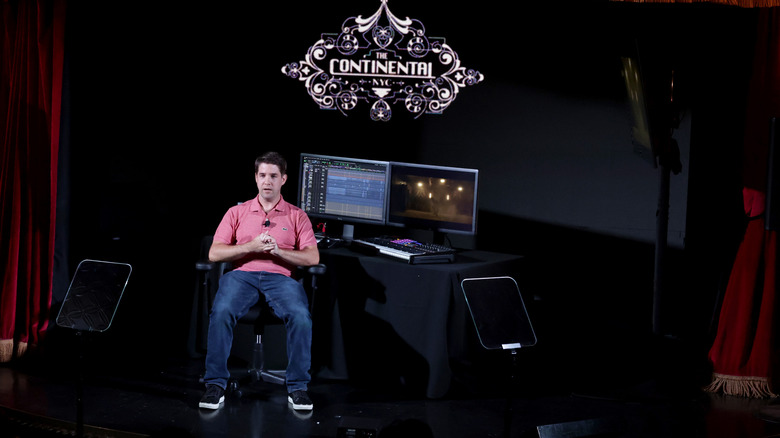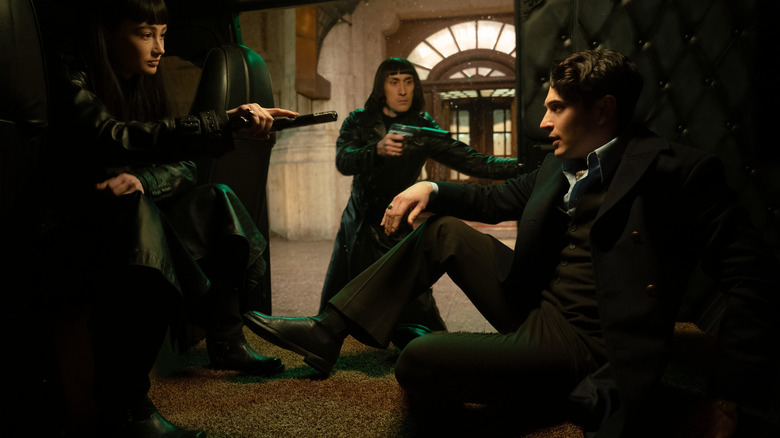I Checked Into The Continental, And Found A John Wick Spin-Off With Something To Prove
The "John Wick" films are action masterpieces, but let's face it: They're tightly focused on Mr. Wick and his battle against the High Table of assassins. With a world surrounding him that's enticingly rich, intriguingly layered, and ambiguously constructed, there's a wealth of possibility for other stories to be found within that world — stories that have the potential to be just as exciting.
That's where Peacock's new three-night event series "The Continental: From the World of John Wick" comes in. Written by Greg Coolidge, Kirk Ward, Ken Kristensen, and Shawn Simmons and directed by Charlotte Brändström (Night 2) and Albert Hughes (Nights 1 & 3), the series is set in 1970s New York City and follows a young Winston Scott (Colin Woodell) as he attempts to avenge his brother Frankie (Ben Robson) and take over the mysterious hotel full of assassins known as The Continental.
I had the pleasure of attending a special event celebrating the series recently, which was held at the Hollywood Roosevelt Hotel. The building had been transformed into The Continental, and I, along with other attendees, witnessed a series of talks and demonstrations from the show's director, executive producers, costume designer, action director, production designer, and sound editor — including the choreographing of a fight scene in real time.
A show born from an Easter egg
As things got started, we were taken into the Roosevelt's opulent, speakeasy-esque "CineGrill" room to have a "fireside chat" with Hughes and executive producers Erica Lee and Basil Iwanyk. The latter explained how the entire crux of "The Continental" series is spun off from a throwaway line delivered by Ian McShane's Winston Scott in the first "John Wick":
"The irony is that the whole show was based on an Easter egg from the first movie, which I don't even remember. Apparently, Winston says, 'I've been a member of this institution,' or 'I've been running this place for 35 years,' and that was the premise of the writers coming in and saying, 'You know that line in 'John Wick?' And we're like, 'We don't remember that line.' 'But there's a line in 'John Wick' and that's where we're going to start.'"
Of course, there are some more traditional Easter eggs to be found in "The Continental," both from the Wick-verse (like the appearance of Wick's 1969 Mustang Boss 429) and other films and TV — a setpiece seen elsewhere during the day contained graffiti that read "Come out and play," a reference to David Patrick Kelly's immortal line from 1979's "The Warriors" as well as "John Wick Chapter 4."
Ultimately, though, the main element Hughes, Iwanyk, and Lee seemed to be excited about is the fact that "The Continental" brings the world of "John Wick" to the so-called small screen without sacrificing the movies' distinctive aesthetics or action. As Iwanyk elaborated:
"We always said, 'Don't make it bigger, make it cooler.' [...] In some ways, of all the action franchises in Hollywood, it was the most applicable for the relative budget constrictions of television, because we didn't need to blow up a city block and it wasn't about tanks or planes. It was two people in a phone booth fighting, which is awesome. And you can't get any smaller. It's literally — that's part of the joy of the fight. But it's not bigger, it's just cooler, which is what we always said on the films and the TV show."
Bringing the 1970s to Wick action
A hallmark of the "John Wick" franchise is the way it blends together a number of aesthetics, from the cinematography, to props, cars, costumes, and so on. It does this well enough so that one can't easily say exactly which year "John Wick" takes place. "The Continental" sets the series distinctly in the 1970s (with real-world issues like NYC's sanitation strike cropping up), but continues that original tradition by not quite committing to a specific year during that decade.
Such a choice allowed costume designer Sarah Arthur free rein to be inspired by both real-life fashion designers of the period as well as larger-than-life designs seen in famous '70s-set films. As she explained:
"Obviously I did a lot of research into the '70s. It's 50 years ago. It didn't feel like that, though, because there are so many resurgences of the '70s fashion. I wanted to give the actors an authenticity and some chemistry for them to get into their parts. So I found lots of original pieces, which I used a great deal. I found fantastic photographic references from Studio 54, Ian Schrager's book. Allan Tannenbaum's 'New York in the 70s,' incredible photography. And of course the Studio 54 documentary. I watched some of the '70s-inspired films like 'Taxi Driver' [and] 'Carlito's Way,' and took on board what the designers of those films had done. But obviously wanted to create my own designs to make 'The Continental' unique to us."
Arthur showed off a number of the costumes she designed and created for the show in person, including the wild, comic-book-esque designs for the murderous Hansel and Gretel twins (Mark Musashi and Marina Mazepa) and the striking outfit for this series' masked Adjudicator (Katie McGrath). One of the most important elements Arthur had to keep in mind was that just about every actor's costume had to be able to move along with the series' action, something she told me about at a roundtable chat later in the day:
"I knew that there was going to be enormous amounts of stunts and action. So, one of my first things was to get 150 suits made of all sizes and out of a cloth that had flexibility. [...] So I had those made outside and the same with the shirts, and it saved so much that would've been a huge problem if I hadn't done that. It was just something that I knew I needed, and there were multiples of the same sizes. Frankie, in the opening sequence, he had to jump through shafts and all of that business. He had to run upstairs and two stairs at a time or three stairs. So we ended up putting lycra on the inside of his trousers, but you couldn't see it. It is little tricks like that."
Literally phoning the action in
Next, we were whisked off to another suite in the hotel, one outfitted with all the accoutrements needed to make an action TV series: A couple of black crash mats on the floor in front of a '70s NYC set, with a graffiti-laden phone booth at its center. This is where production designer Drew Broughton got to explain a little about his efforts in creating the sets of "The Continental," and where action director Larnell Stovall gave us a live demonstration of the techniques he likes to use when choreographing a fight.
Broughton spoke a bit about building environments that support the story and the action choreography, something he elaborated on later during a roundtable discussion:
"One of the differences between good production design and bad production design in an action film is if the things look fake, they break apart. If it looks like balsa wood, or if it looks too easy. So it's like this very kind of sophisticated [process]: All these different artists are involved in making sure that whatever the material that we use is just right, looks right. What we never want is for our work to distract from [the action], to take away the moment, because it will take you right out of the movie if, 'Oh, they just went through a balsa wood barricade.'"
During the demonstration, Stovall explained that the actress who plays the role of Lou, Jessica Allain, had never done any on-screen fights in her career before, and, due to the nature of TV production, there was no time for the months-long training regimens typically arranged for actors in big-budget action films. So, he adopted a technique where he assigns each move a behavior and emotion. For example, if you're throwing a punch, you can begin by "picking up a phone" and then "giving the other person the phone." Stovall brought up two volunteers from the audience, teaching them a combination using that technique in record time, so that each person was able to perform it on the spot in the phone booth with relative ease.
It was a real-time example of Stovall's approach to screen action, using some of his own techniques as well as those espoused by the 87eleven design team that has worked on all of the "Wick" movies. During the later roundtable discussion, Stovall explained how working with production design can elevate the action's impact:
"You need to do something else to make the average person who doesn't understand martial arts go, 'Ooh, that hurt.' Because they don't know this technique. They don't know this chop. They don't know how strong that side kick was. But if I kick somebody into an urn and it falls and destroys, you can go, "That was powerful," which gives us a little break in the sense of the Chopsocky world and breaks things up."
The world's most deadly keyboard
Venturing back to the CineGrill, the stage was now set up with equipment belonging to sound editor Luke Gibleon. At its center was a keyboard with some curious labeling on each key, labels that only made sense after Gibleon ran through a demo of the show's opening fight sequence. In it, Frankie has just stolen something belonging to the High Table from the Continental on New Year's Eve, and is fighting his way out of the hotel up a huge stairwell. Gibleon played us the scene as finished, then again with the sound effects removed (while keeping music, dialogue, and foley intact).
It turns out that his keyboard was programmed with all the necessary gunshot sounds needed in the scene: A chunkier blast for Frankie's hero gun, a less bass-y sound for the bad guys' gunshots, as well as attendant whizzes and ricochet sounds from when the bullets would hit wood or metal. Bringing up two volunteers, Gibleon had them try and perform the sound effects in real time, resulting in the expected amusing effect of seeing a gun fire and hearing the blast a split second later. Proving that it could be done, Gibleon performed the entire scene by himself, so naturally you'd almost swear he'd been cheating.
Later, during a roundtable, Gibleon spoke about how, as a veteran of the "Wick" films, he approached designing the sound for a show, knowing most audience members will be listening to it through smaller speakers than a movie theater's:
"Where my mind goes...is to almost overdesign and overemphasize, because I'm aware that people are hearing it on [TV] speakers. And the way Albert's style is, we're really hitting things. So I kind of went bigger and larger than life in moments, so that I knew that when they happen on a TV screen, that we would get a chance to hear and feel them. One of the important things was actually [that] I worked on all the 'John Wick' films, it was necessary that I had done that. So I at least already had a knowledge of what to do with those action scenes and what to do with that kind of sound. So it gave me a chance then with all the other work I had to do, that was totally Albert's style, it gave me a chance to spend time crafting that, because you are limited on time and budget and everything."
'The Continental' has something to prove
As the day wrapped up, we spoke to the crew of "The Continental" at various roundtables, and throughout these conversations, it became apparent that everyone who made the show was passionate about it on two levels. One was the normal love of their craft, but the other level was that, knowing they're following four of the most acclaimed action films of all time, they had something to prove. Albert Hughes summed that attitude up nicely while discussing the morale of the crews he worked with in Budapest:
"[The crews] also have this chip on their shoulder that a biracial kid also has on his shoulder, that a person from a small country has on their shoulders. 'Well, they're underestimating me because I'm not in a big town. I don't live in Hollywood and I don't...' You get that little attitude, 'F*** these motherf***ers. I'm going to prove this to them.' And that's the attitude. 'You guys think you know what's best? Watch.' So I was quite taken and enamored and shocked by it and touched by it. I also think the benefit was they all knew about the IP. They all were 'Wick' fans. And I keep having to remind myself, 'Albert, they may have liked you. They didn't like you that much.' [laughs] They love the 'John Wick' world and they understand it. And they were really, I would say ambitious. When you're a small country or a small person, or a minority, you have to be ambitious."
Despite the ambition of "The Continental," the people behind the John Wick series have a healthy approach to continuing and expanding its world from here. As Basil Iwanyk explained:
"I think as soon as you hear the word 'universe,' you go, 'Oh man.' You roll your eyes. Because that's like the new bulls*** du jour. [...] There is almost an agonizing self-reflection of, 'How can we do more stuff to build out the world, yet still keep quality, and it still being cool and without anything smelling like a money grab?' Because, God bless Lionsgate. Tomorrow, they could make three different 'John Wick' movies — and I don't mean John Wick, but spin-offs, and we [could] make a lot of money on it, but we have this kind of interesting legacy. [...] We just want to be methodical about it. We want to be respectful of the audience's expectation and not f*** up, which, easier said than done."
Erica Lee added, "We're trying to be really thoughtful about it and it needs to make sense." Only time will tell if "The Continental" makes sense when it premieres on Peacock September 22, 2023. Tick tock.
